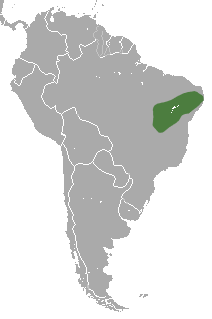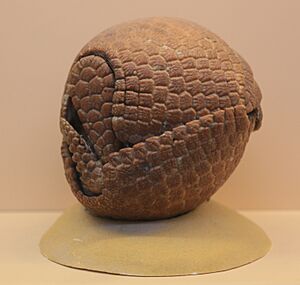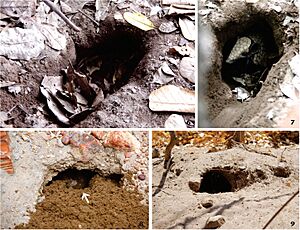Brazilian three-banded armadillo facts for kids
Quick facts for kids Brazilian three-banded armadillo |
|
|---|---|
 |
|
| Conservation status | |
| Scientific classification | |
| Genus: |
Tolypeutes
|
| Species: |
tricinctus
|
 |
|
| Brazilian three-banded armadillo range | |
| Synonyms | |
|
|
The Brazilian three-banded armadillo (its scientific name is Tolypeutes tricinctus) is a special type of armadillo found only in eastern Brazil. People in Brazil call it tatu-bola, which means "ball armadillo." This name is perfect because it's one of only two armadillo species that can roll up into a tight, protective ball! Sadly, its population has dropped by 30% in the last 10 years.
Contents
What Does a Brazilian Three-Banded Armadillo Look Like?
Brazilian three-banded armadillos are about 22 to 27 centimeters (9 to 11 inches) long, not counting their tail. Their tail adds another 6 to 8 cm (2 to 3 inches). They usually weigh between 1 and 1.6 kilograms (2.2 to 3.5 pounds).
Their body is covered by a tough armor made of bony plates. These plates are covered by hard, scaly skin. The armor covers their back, sides, head, tail, ears, and the outside of their legs. But their belly and the inside of their legs are soft and covered with long, coarse hair.
The Brazilian three-banded armadillo is special because its armor is a bit looser than other armadillos. This allows it to move more freely and, most importantly, roll into a perfect ball. This loose armor also creates a layer of air between its shell and body, which helps keep it warm or cool. This means they can live in drier places than some other armadillo species. When they roll up, their ears tuck inside, and their head and tail fit together perfectly to seal the ball.
Their teeth are soft and peg-like. They are perfect for crushing the hard outer shells of insects.
Where Do These Armadillos Live and What Do They Eat?
Home Sweet Home: Range and Habitat
As their name suggests, Brazilian three-banded armadillos live only in Brazil. You can find them mostly in the northeastern part of the country, just south of the equator.
They prefer to live in open grasslands called Cerrado and dry woodlands known as Caatinga. These areas don't get much rain, and the soil isn't very rich. So, the plants there are mostly tall grasses, scattered bushes, and twisted trees. In the northern parts of their home, you'll also see many cactus-like plants. These armadillos can dig their own burrows for shelter, but they often use burrows that other animals have already dug.
What's on the Menu? Diet
Their favorite foods are ants and termites. They have an amazing sense of smell and can sniff out these insects up to 20 cm (8 inches) deep in the soil! When they find prey, they quickly dig a hole and stick their nose in. Then, they use their long, sticky tongue to slurp up the insects. They also eat other things like mollusks, worms, fruit, and even dead animals (called carrion).
How Do Brazilian Three-Banded Armadillos Behave?
Armadillos usually live alone. However, Brazilian three-banded armadillos sometimes travel in small family groups of up to three members. They are mostly active at night, but you might see them looking for food during the day too.
Most armadillos are excellent diggers. But unlike other species, three-banded armadillos don't dig to defend themselves or find shelter. They prefer to rest under bushes instead of digging burrows. Their special ability to roll into a ball means they don't need to dig for defense.
When they are not looking for food, they move with a unique trot. They bounce on the tips of their front toes, while their back feet slap flatly on the ground. They mark their areas using special scents from glands on their face, feet, and rump.
When they feel threatened, they sometimes don't close their armor all the way. They wait until something touches them, then quickly snap shut. This sudden movement can surprise a predator!
Baby Armadillos: Reproduction
The mating season for these armadillos is from October to January. After a short courtship, the female carries her young for about 120 days. She usually gives birth to one baby, which is born blind.
Even though the baby's armor is soft at birth, its claws are fully grown. It can walk and roll into a ball within hours of being born! The armor becomes hard by the third or fourth week. Around this time, the baby's eyes and earflaps also open. Young armadillos stop drinking milk at 10 weeks old and can have their own babies when they are 9 to 12 months old.
What Threats Do They Face?
The Brazilian three-banded armadillo's ability to roll into a ball protects it from most predators. Only large animals like pumas and jaguars are strong enough to be a natural threat.
However, the biggest danger to these armadillos is humans. Their homes are being destroyed to make space for livestock farms. Also, people hunt them a lot. Because they roll into a ball when scared, they are easy to catch for food. This has caused their numbers to drop a lot. Growing farms, mining, and cutting down trees for charcoal are also damaging their habitat.
The 2014 FIFA World Cup Mascot
In January 2012, a Brazilian environmental group called the Caatinga Association started a campaign. They suggested that the three-banded armadillo should be the mascot for the 2014 FIFA World Cup, which Brazil was hosting. In March 2012, a Brazilian magazine reported that the armadillo would indeed be the official mascot. The official announcement came in September 2012, and the mascot was named Fuleco.
See also
 In Spanish: Tolypeutes tricinctus para niños
In Spanish: Tolypeutes tricinctus para niños




